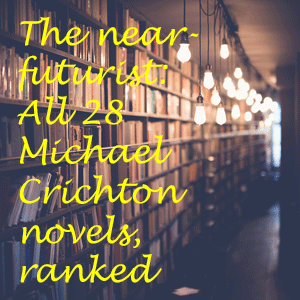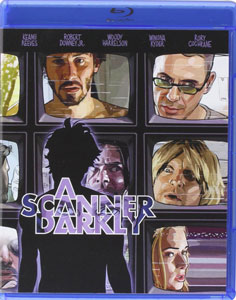Writer-director Richard Linklater lovingly adapts “A Scanner Darkly” – Philip K. Dick’s 1977 classic about drug use and the drug war set amid a future drug-producing spy state – but the 2006 film is also an example of how movies can play flatter than the novel even when faithfully translated. The film is also notable for using interpolated rotoscoping, in which live-action frames are given an animated look, a technique also used in this fall’s Amazon Prime TV series “Undone.”
Rotoscope animation
The pros and cons of the rotoscope animation even out, I think. Early on, I thought “I want to see the real actors, in clean frames.” But I got used to it. The technique allows for the natural inclusion of the scramble suit worn by undercover police detective “Fred”/Bob Arctor (Keanu Reeves) – this is something that has to be animated. This suit runs through an infinite number of images of humans, thus rendering the wearer unidentifiable; I think one of the images is of a bearded PKD.
The casting is impeccable, as everyone fits the characters PKD wrote, and coincidentally they are mostly actors who would enjoy a career resurgence five to 10 years after “A Scanner Darkly.” Reeves’ laid-back demeanor, with a dash of confusion, works well for Arctor, whose mind gets burned out over the course of events.

“A Scanner Darkly” (2006)
Director: Richard Linklater
Writers: Philip K. Dick, Richard Linklater
Stars: Keanu Reeves, Winona Ryder, Robert Downey Jr.
Robert Downey Jr. is especially good as Barris, one of those guys for whom it’s so important to be the smartest guy in the room; he ultimately gets outsmarted by an organization more twisted than he is: the local police.
Woody Harrelson is the third housemate, Luckman, who adds extra paranoia to complement Barris’ and Arctor’s. Rory Cochrane is Freck, he of the “aphids” in his hair, who hangs on longer in the movie than in the novel (and he gets Luckman’s attempted suicide scene from the book). Winona Ryder is Donna, Bob’s dealer/girlfriend who doesn’t like to be touched.
Linklater pens a smart screenplay, staying true to the novel’s message but tightening scenes or characters in logical ways. A nice touch is when Bob’s superior, “Hank,” pulls of “his” scramble suit to reveal Donna. There’s a more pointed conclusion here, as we see Donna feels horrible for what she has done to Bob – making him into the infiltrator of New-Path without his consent and at the cost of his mind. Yet there’s also a hopeful ending, as Bob tucks away a blue flower (used for making Substance D), suggesting that word of the US government’s drug production might get out.
Smart additions
Linklater adds a scene of a man protesting the spy state, getting tased and being thrown into a dark van. PKD’s novel takes a “take it for granted” approach to the future spy state; a reader assumes everyone is accustomed to it. If you think about it, that’s even scarier than a situation where protesters disappear, but Linklater’s approach is more dramatic. With “A Scanner Darkly’s” narrative advancing in such an understated fashion, I understand his desire to punch things up.

Even with that effort, “A Scanner Darkly” plays a little flat. The movie is consistently a downer, whereas the book is sometimes funny. (The movie starts the joke about the group’s confusion over the number of speeds on the bicycle but doesn’t include the punchline. But I don’t know if the humor would translate anyway.) Because of the lack of emotional swings, the tragedy is muted.
But I’m probably better off than someone who hadn’t read the book. To a newcomer, the movie might play as a boring, impenetrable drug trip. (It is a drug-trip story, but it’s very penetrable in book form, which is why it’s a masterpiece.)
Despite my criticisms, I’m glad we have this “A Scanner Darkly” adaptation. It’s clear Linklater and the actors understand the bizarre and tragic source material. For a novel that is at first blush unadaptable, this movie does a respectable job.

